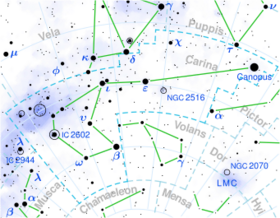Astronomy:HD 93194
From HandWiki
Short description: Star in the constellation Carina
Location of HD 93194 in IC 2602 (circled) | |
| Observation data Equinox J2000.0]] (ICRS) | |
|---|---|
| Constellation | Carina |
| Right ascension | 10h 44m 06.91549s[1] |
| Declination | −63° 57′ 39.8535″[1] |
| Apparent magnitude (V) | 4.85[2] |
| Characteristics | |
| Spectral type | B3/5Vn[3] |
| U−B color index | −0.625[2] |
| B−V color index | −0.145[2] |
| Astrometry | |
| Parallax (π) | 6.63 ± 0.18[1] mas |
| Distance | 490 ± 10 ly (151 ± 4 pc) |
| Absolute magnitude (MV) | −1.176[4] |
| Details | |
| Mass | 5.4[5] M☉ |
| Radius | 4.7[6] R☉ |
| Luminosity | 676[5] L☉ |
| Surface gravity (log g) | 4.10[5] cgs |
| Temperature | 14,761[5] K |
| Metallicity [Fe/H] | −0.10[7] dex |
| Rotational velocity (v sin i) | 310[8] km/s |
| Age | 175[9] Myr |
| Other designations | |
| Database references | |
| SIMBAD | data |
HD 93194 (HR 4205) is a star in the constellation Carina. Its apparent magnitude is 4.79. Its parent cluster is IC 2602.
HD 93607 is a B4 main sequence star, notable for "nebulous" absorption lines caused by its rapid rotation.[3] It is included on a list of the least variable stars amongst those observed by the Hipparcos satellite, with a possible variation less than 0.01 magnitudes.[10]
References
- ↑ 1.0 1.1 1.2 Van Leeuwen, F (2007). "Validation of the new Hipparcos reduction". Astronomy and Astrophysics 474 (2): 653–664. doi:10.1051/0004-6361:20078357. Bibcode: 2007A&A...474..653V.
- ↑ 2.0 2.1 2.2 Mermilliod, J.-C (1986). "Compilation of Eggen's UBV data, transformed to UBV (unpublished)". Catalogue of Eggen's UBV Data. Bibcode: 1986EgUBV........0M.
- ↑ 3.0 3.1 Houk, N; Cowley, A. P (1975). University of Michigan Catalogue of two-dimensional spectral types for the HD stars. Volume I. Declinations -90° to -53.0°. Bibcode: 1975mcts.book.....H.
- ↑ Silaj, J; Landstreet, J. D (2014). "Accurate age determinations of several nearby open clusters containing magnetic Ap stars". Astronomy & Astrophysics 566: A132. doi:10.1051/0004-6361/201321468. Bibcode: 2014A&A...566A.132S.
- ↑ 5.0 5.1 5.2 5.3 Fouesneau, M.; Andrae, R.; Dharmawardena, T.; Rybizki, J.; Bailer-Jones, C. A. L.; Demleitner, M. (2022). "Astrophysical parameters from Gaia DR2, 2MASS, and AllWISE". Astronomy and Astrophysics 662: A125. doi:10.1051/0004-6361/202141828. Bibcode: 2022A&A...662A.125F.
- ↑ Kervella, Pierre; Arenou, Frédéric; Thévenin, Frédéric (2022). "Stellar and substellar companions from Gaia EDR3". Astronomy & Astrophysics 657: A7. doi:10.1051/0004-6361/202142146. Bibcode: 2022A&A...657A...7K.
- ↑ Anders, F.; Khalatyan, A.; Chiappini, C.; Queiroz, A. B.; Santiago, B. X.; Jordi, C.; Girardi, L.; Brown, A. G. A. et al. (2019-08-01). "Photo-astrometric distances, extinctions, and astrophysical parameters for Gaia DR2 stars brighter than G = 18". Astronomy and Astrophysics 628: A94. doi:10.1051/0004-6361/201935765. ISSN 0004-6361. Bibcode: 2019A&A...628A..94A.
- ↑ David, Trevor J; Hillenbrand, Lynne A (2015). "The Ages of Early-type Stars: Strömgren Photometric Methods Calibrated, Validated, Tested, and Applied to Hosts and Prospective Hosts of Directly Imaged Exoplanets". The Astrophysical Journal 804 (2): 146. doi:10.1088/0004-637X/804/2/146. Bibcode: 2015ApJ...804..146D.
- ↑ Gontcharov, G. A. (2016). "VizieR Online Data Catalog: Thin disk BV-GV Hipparcos stars within 333pc (Gontcharov+, 2012)". Vizier Online Data Catalog. Bibcode: 2016yCat..90380860G.
- ↑ Adelman, S. J (2001). "Research Note Hipparcos photometry: The least variable stars". Astronomy and Astrophysics 367: 297–298. doi:10.1051/0004-6361:20000567. Bibcode: 2001A&A...367..297A.
 |


